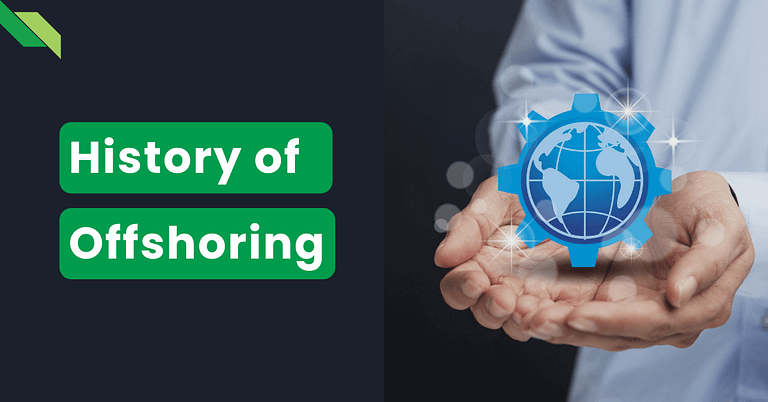Last Updated on 2025-03-05
Many companies are strategically relocating their business operations overseas. How and why do so many companies go overseas? Let’s take a trip down memory lane and learn the history of offshoring.
Offshoring is the practice of outsourcing a business process to another country. Highly industrialized countries, such as the US, usually offshore to developing countries to reduce their operational cost. Other reasons why companies choose to go offshore are:
- Better tax benefits
- Access to cheap raw materials
- Favorable labor regulations
- Less stringent environmental policies.
Generally, offshoring starts by creating a subsidiary or outsourcing through a third-party service provider. It involves a high level of trust, coordination, and communication to transfer the management control to an offshore vendor.
Offshoring can either be a production offshoring or services offshoring. With production offshoring, companies relocate their manufacturing processes to an offshore country.
On the other hand, services offshoring is the transfer of the company’s administrative or knowledge services like sales and marketing, human resources, accounting and finance, and software development.
Now let’s move on to the fun part. When did offshoring begin? How did it spur growth in our global economy today? Let us answer these questions in the next section.
Related Video: Startup Hustle TV, A Web Series About Entrepreneurship
History of Offshoring: How It All Started
The outsourcing, nearshoring, and offshoring trend began in the 60s and 70s as large corporations transferred their manufacturing processes to lower-cost countries. General Electric was one of the pioneers of outsourcing at the time.
Other chief examples are US firms that moved production to factories in Mexico under the Maquiladora system. A maquiladora is a manufacturing plant or factory licensed to operate under Mexico’s Secretariat of Commerce and Industrial Development.
Maquiladoras were built in the 1960s to encourage foreign investments and ease unemployment problems in Mexico. Employment in maquiladora increased from roughly 200,000 in the 1980s to over 1 million jobs in the late 90s. Other countries soon followed and took advantage of the system. In fact, many manufacturing companies in Japan produced goods under the maquiladora system in the 1980s.
Over time, offshore manufacturing moved to other lower-cost countries like India, China, the Philippines, and Eastern Europe. Despite the high costs of transportation, duties, docks, and brokers, most of these companies found that a 30-50% labor cost reduction is enough to compensate for these expenses.
Offshoring during the IT Revolution
In the 1990s, the world saw the boom of the Internet and telecommunications. The IT revolution led to the rapid growth of IT-enabled offshoring services. The popularity of information technology made location less significant since data can be transmitted digitally.
The type of work exported around this time was more skilled and sophisticated than its predecessors. Global corporations like Dell and IBM began tapping skilled labor overseas to fill call center, financial, and IT jobs.
The costs of internet installations and telecommunication devices decreased over the years. With that, many businesses have warmed up even more to outsourcing some of their white-collar functions to workers abroad.
Crucial factors that drive IT offshoring is the apparent disparity in salaries and cost of living between developed and less-developed countries. For example, the wages of Filipino software developers are significantly less than their American counterparts because of the affordable cost of living and currency exchanges in the Philippines.
In addition, international talent may also improve innovation output within a company. For instance, that’s one reason why foreign markets that welcome global entrepreneurs and skilled workers often have denser and more successful start-up climates.
Related Video: Leadership Skills for Remote Teams
Hire an Offshore Development Team with Full Scale
Interestingly, the offshoring model has come a long way, with no signs of slowing down anytime soon. More and more companies will choose to offshore to meet their business goals and scale them to greater heights.
If you’re starting your offshoring journey, we recommend you work directly with the experts. We are Full Scale, an Inc. 5000-listed fast-growth company in the US. Headquartered in both Kansas City and the Philippines, our top-notch software services team helps our clients scale up their businesses.
We provide the best-in-class recruitment of software developers so you can laser focus on what matters most—your core business.
Build your Offshore Software Team with Full Scale today!

Matt Watson is a serial tech entrepreneur who has started four companies and had a nine-figure exit. He was the founder and CTO of VinSolutions, the #1 CRM software used in today’s automotive industry. He has over twenty years of experience working as a tech CTO and building cutting-edge SaaS solutions.
As the CEO of Full Scale, he has helped over 100 tech companies build their software services and development teams. Full Scale specializes in helping tech companies grow by augmenting their in-house teams with software development talent from the Philippines.
Matt hosts Startup Hustle, a top podcast about entrepreneurship with over 6 million downloads. He has a wealth of knowledge about startups and business from his personal experience and from interviewing hundreds of other entrepreneurs.





